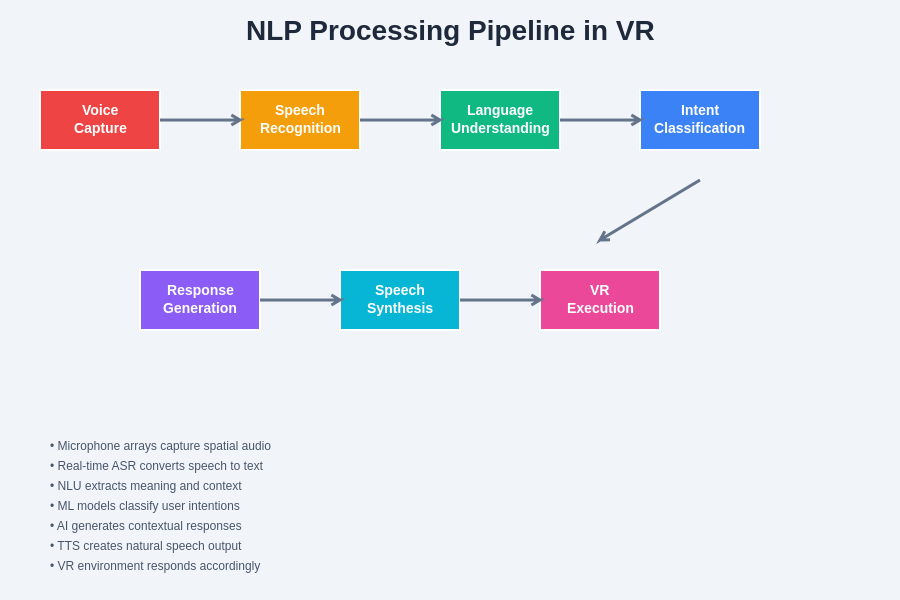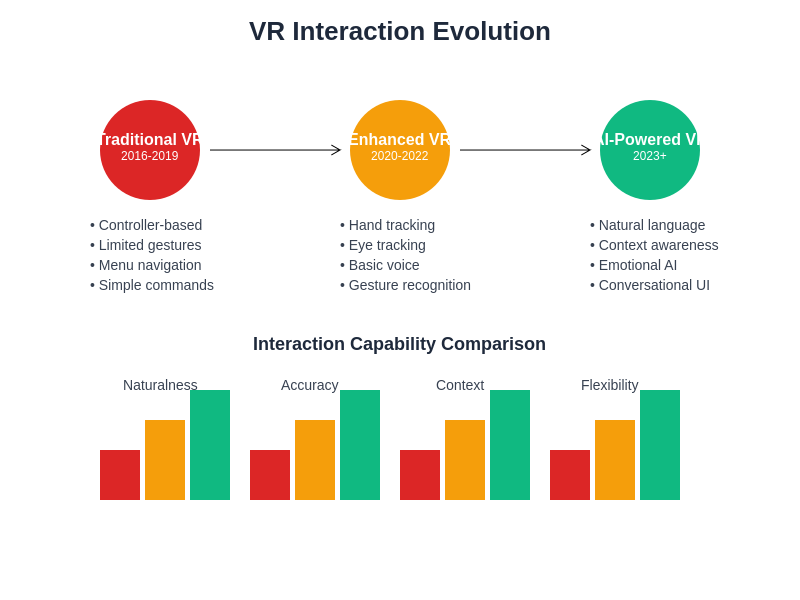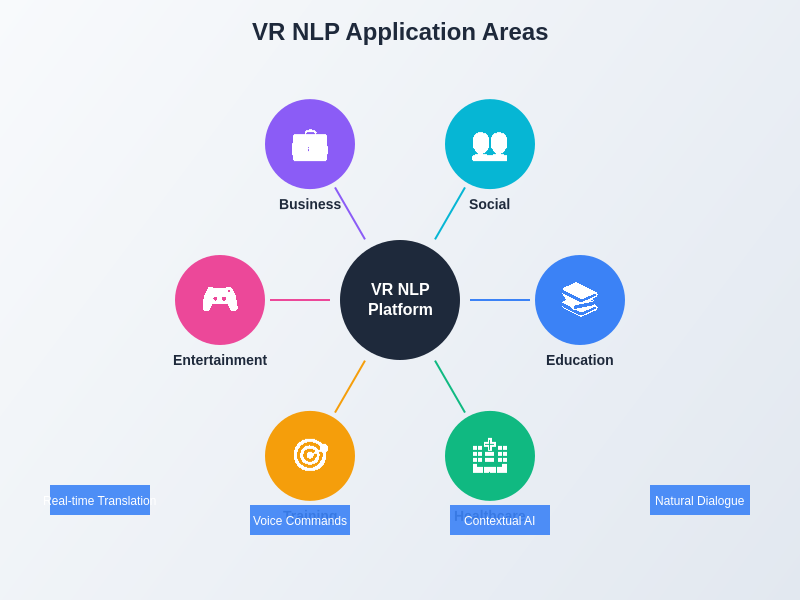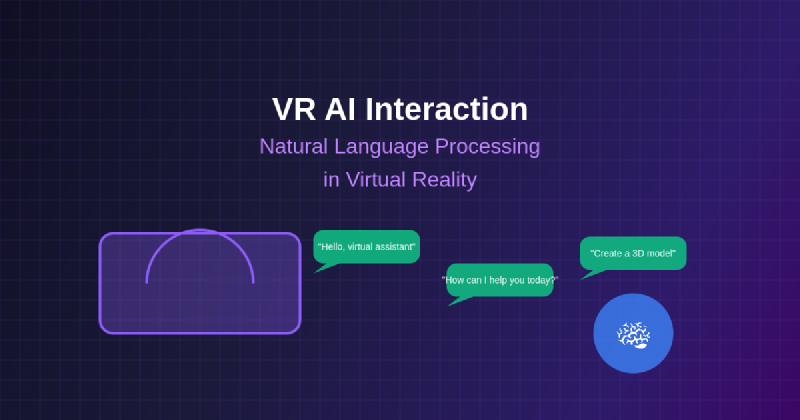The convergence of virtual reality and artificial intelligence has ushered in a transformative era where natural language processing capabilities are fundamentally reshaping how humans interact with digital environments. This revolutionary synthesis of immersive technology and intelligent language understanding is creating unprecedented opportunities for intuitive, natural, and deeply engaging virtual experiences that blur the lines between physical and digital interaction paradigms.
Explore the latest AI trends in immersive technologies to understand how cutting-edge developments in virtual reality and artificial intelligence are creating new possibilities for human-computer interaction. The integration of sophisticated natural language processing systems into virtual reality environments represents a quantum leap forward in creating truly responsive and intelligent digital worlds that understand, interpret, and respond to human communication with remarkable precision and contextual awareness.
The Evolution of Virtual Reality Communication
Traditional virtual reality interfaces have long relied on controller-based interactions, gesture recognition, and primitive voice commands that limited the natural flow of communication between users and virtual environments. The introduction of advanced natural language processing capabilities has fundamentally transformed this landscape by enabling sophisticated conversational interfaces that can understand complex verbal instructions, respond to nuanced queries, and maintain contextual awareness across extended interaction sessions.
This evolution represents far more than a simple upgrade to existing input methods. Natural language processing in virtual reality creates an entirely new paradigm where users can communicate with virtual environments using the same linguistic complexity and subtlety they would employ in real-world conversations. The technology enables virtual assistants, characters, and environmental systems to process semantic meaning, understand intent, recognize emotional context, and provide appropriate responses that enhance immersion while maintaining the natural flow of human communication patterns.
The sophistication of modern NLP systems allows for real-time processing of spoken language with remarkable accuracy, even in the challenging acoustic environments that VR headsets can create. Advanced noise cancellation, directional microphone arrays, and intelligent audio processing ensure that voice recognition remains reliable and responsive regardless of environmental factors or user movement patterns within virtual spaces.

The complex technical infrastructure required for natural language processing in virtual reality environments involves multiple processing stages that must operate seamlessly in real-time. From initial voice capture through speech recognition, language understanding, intent classification, response generation, speech synthesis, and final VR execution, each component must maintain low latency while delivering high accuracy to preserve the immersive experience.
Revolutionary Applications in Virtual Environments
The implementation of natural language processing in virtual reality has opened unprecedented avenues for creating intelligent, responsive, and deeply immersive digital experiences that adapt to user communication patterns and preferences. Virtual training simulations now incorporate AI-powered instructors capable of providing personalized feedback, answering complex questions, and adapting instruction methodologies based on individual learning styles and progress patterns.
Experience advanced AI capabilities with Claude for sophisticated natural language understanding that can power next-generation virtual reality applications. Educational virtual reality environments have been particularly transformed by NLP integration, enabling students to engage in natural conversations with historical figures, scientific concepts personified as interactive characters, and virtual laboratory assistants that can explain complex procedures while providing real-time guidance and safety monitoring.
Entertainment applications have similarly benefited from this technological convergence, with virtual reality games featuring non-player characters capable of engaging in meaningful dialogue, understanding player intentions, and adapting storylines based on conversational choices and communication patterns. These advances create dynamic narrative experiences where player agency extends beyond traditional binary choice systems into nuanced conversational interactions that influence game world development and character relationship dynamics.
Transforming Social Virtual Reality Experiences
Social virtual reality platforms have experienced revolutionary transformation through the integration of sophisticated natural language processing capabilities that enable more natural, engaging, and meaningful interpersonal interactions within digital environments. Advanced translation systems now provide real-time language conversion, enabling seamless communication between users speaking different languages while preserving emotional tone, cultural context, and conversational nuance.
The technology extends beyond simple translation to include sentiment analysis, emotional recognition, and contextual understanding that enables virtual environments to respond appropriately to social dynamics, group conversations, and individual communication preferences. Virtual meeting spaces equipped with NLP capabilities can automatically generate meeting summaries, identify action items, and provide intelligent facilitation support that enhances productivity while maintaining the natural flow of collaborative discussion.
Privacy-conscious implementations ensure that voice data processing occurs locally or through secure, encrypted channels that protect user communication while enabling the sophisticated analysis required for advanced natural language understanding. These systems balance the need for comprehensive language processing with stringent privacy requirements that maintain user trust and regulatory compliance across diverse global markets and use cases.
Advancing Accessibility Through Intelligent Interface Design
Natural language processing in virtual reality has created unprecedented opportunities for enhancing accessibility and inclusion by providing alternative interaction modalities that accommodate diverse user needs, abilities, and preferences. Voice-controlled navigation systems enable users with mobility limitations to explore virtual environments through spoken commands, while intelligent captioning systems provide real-time transcription of spoken dialogue for users with hearing impairments.
The technology extends to creating personalized accessibility features that adapt to individual user requirements through machine learning analysis of communication patterns and interaction preferences. Virtual reality systems can now automatically adjust interface complexity, provide contextual assistance, and offer alternative interaction methods based on user capabilities and stated preferences, creating truly inclusive digital experiences that accommodate the full spectrum of human diversity.
Advanced natural language processing enables virtual reality systems to understand and respond to accessibility-related requests in real-time, automatically adjusting environmental factors, interface elements, and interaction paradigms to optimize usability for individual users. These adaptive systems learn from user behavior patterns and feedback to continuously improve accessibility support while maintaining the immersive quality of virtual experiences.

The evolution of virtual reality interaction methods demonstrates a clear progression from traditional controller-based systems through enhanced hand and eye tracking capabilities to the current generation of AI-powered natural language interfaces. This technological advancement has dramatically improved the naturalness, accuracy, contextual understanding, and flexibility of human-computer interaction within virtual environments.
Enhancing Professional Training and Simulation
Professional training applications represent one of the most impactful implementations of natural language processing in virtual reality, where sophisticated AI systems can simulate complex real-world scenarios while providing intelligent feedback, guidance, and assessment capabilities. Medical training simulations now feature virtual patients capable of describing symptoms in natural language, responding to diagnostic questions, and exhibiting realistic emotional responses that enhance the training experience’s authenticity and educational value.
Discover comprehensive AI research capabilities with Perplexity for developing sophisticated training simulations that incorporate the latest advances in natural language processing and virtual reality technology. Aviation training simulators integrate NLP capabilities that enable realistic air traffic control communications, emergency response protocols, and multi-crew coordination exercises that prepare pilots for the complex communication challenges they will encounter in real-world flight operations.
Corporate training programs leverage natural language processing to create virtual mentors and coaches capable of providing personalized instruction, answering complex questions about company policies and procedures, and facilitating interactive learning experiences that adapt to individual learning styles and professional development goals. These systems can assess communication skills, provide constructive feedback on presentation techniques, and simulate challenging workplace scenarios that prepare employees for real-world professional interactions.
Revolutionizing Creative and Artistic Expression
The creative potential of natural language processing in virtual reality extends far beyond traditional productivity applications into realms of artistic expression, creative collaboration, and innovative content creation that were previously impossible or prohibitively complex. Virtual reality creation tools now incorporate AI assistants capable of understanding artistic intent expressed in natural language and translating these descriptions into visual, auditory, and interactive elements within virtual environments.
Collaborative creative spaces enable multiple artists to work together in virtual environments where natural language serves as a bridge between different creative disciplines, allowing musicians, visual artists, writers, and designers to communicate their ideas and intentions naturally while AI systems facilitate the technical implementation of creative concepts. These environments support real-time creative iteration where spoken descriptions can instantly manifest as visual elements, environmental changes, or interactive behaviors within the virtual space.
Storytelling applications have been particularly transformed by NLP integration, enabling writers and content creators to develop interactive narratives where characters respond dynamically to audience input, storylines adapt based on conversational choices, and immersive worlds evolve organically through natural language interaction. These systems support complex narrative structures while maintaining coherent character development and plot progression across multiple interaction pathways and user engagement patterns.

The diverse application areas for natural language processing in virtual reality span across education, healthcare, professional training, entertainment, business collaboration, and social interaction platforms. Each sector leverages unique aspects of NLP capabilities to create specialized experiences that transform how users interact with information, learn new skills, collaborate with others, and engage with digital content in immersive virtual environments.
Technical Infrastructure and Implementation Challenges
The successful implementation of natural language processing in virtual reality requires sophisticated technical infrastructure capable of handling real-time language analysis while maintaining the low-latency requirements essential for immersive virtual experiences. Edge computing solutions increasingly support local processing of voice recognition and natural language understanding to minimize latency while ensuring responsive interaction capabilities that maintain immersion and user engagement.
Advanced audio processing pipelines incorporate multiple microphone inputs, environmental noise cancellation, and spatial audio analysis to ensure accurate voice recognition regardless of user position, orientation, or environmental factors within virtual spaces. These systems must balance processing complexity with performance requirements while maintaining the consistent frame rates and minimal latency essential for comfortable virtual reality experiences.
Cloud-based processing solutions provide access to sophisticated language models and extensive knowledge bases while implementing secure data transmission protocols that protect user privacy and ensure regulatory compliance. Hybrid approaches combine local processing for immediate response requirements with cloud-based analysis for complex language understanding tasks that benefit from access to large-scale machine learning models and extensive linguistic databases.
Privacy, Security, and Ethical Considerations
The integration of natural language processing in virtual reality raises important considerations regarding user privacy, data security, and ethical implementation of AI systems that process intimate human communication in immersive digital environments. Robust encryption protocols ensure that voice data transmission between devices and processing systems maintains confidentiality while enabling the sophisticated analysis required for advanced natural language understanding capabilities.
Data minimization principles guide the development of systems that process only the information necessary for functionality while implementing automatic deletion protocols for voice recordings and conversation transcripts that are no longer required for system operation. User control mechanisms provide granular privacy settings that allow individuals to determine what information is processed, how long data is retained, and what level of personalization is enabled within their virtual reality experiences.
Ethical AI implementation ensures that natural language processing systems avoid bias, discrimination, and inappropriate responses that could harm users or create uncomfortable virtual experiences. Comprehensive testing protocols evaluate system responses across diverse demographic groups, cultural contexts, and communication styles to ensure fair and appropriate treatment of all users regardless of language patterns, accents, or communication preferences.
Future Directions and Emerging Technologies
The continued evolution of natural language processing in virtual reality promises even more sophisticated capabilities as emerging technologies mature and integration approaches become more refined. Advanced emotional intelligence systems will enable virtual environments to recognize and respond appropriately to subtle emotional cues, stress indicators, and psychological states that influence how users prefer to interact with virtual systems and characters.
Multimodal interaction systems will combine natural language processing with gesture recognition, eye tracking, and physiological monitoring to create comprehensive understanding of user intent and emotional state that enables more nuanced and appropriate responses from virtual systems. These integrated approaches will create virtual experiences that feel increasingly natural and responsive to the full spectrum of human communication modalities.
Brain-computer interface integration represents the frontier of natural language processing in virtual reality, where direct neural signal analysis could enable thought-based communication with virtual systems that bypasses traditional speech recognition entirely. While still in early research phases, these technologies promise to create entirely new paradigms for human-computer interaction that could revolutionize virtual reality experiences by enabling direct mental control and communication with digital environments.
The advancement of quantum computing capabilities will enable real-time processing of increasingly sophisticated language models that can understand context, maintain long-term conversation memory, and provide responses that demonstrate genuine understanding rather than pattern matching. These computational advances will support virtual reality experiences where AI characters and systems exhibit truly intelligent behavior that enhances immersion and creates meaningful interaction possibilities.
Industry Impact and Market Transformation
The integration of natural language processing in virtual reality is driving significant transformation across multiple industry sectors, creating new market opportunities while disrupting traditional interaction paradigms and business models. Enterprise virtual reality solutions increasingly incorporate NLP capabilities that enable more natural and efficient workplace collaboration, training delivery, and remote communication that rivals or exceeds in-person interaction effectiveness.
Healthcare applications continue to expand as natural language processing enables more sophisticated patient interaction simulations, therapeutic virtual environments, and telemedicine applications that provide natural communication interfaces for both patients and healthcare providers. These implementations require particular attention to privacy and regulatory compliance while delivering clinical effectiveness that supports real-world healthcare delivery improvement.
Educational technology markets are experiencing rapid growth as institutions recognize the potential of NLP-enabled virtual reality for creating personalized learning experiences, virtual tutoring systems, and immersive educational content that adapts to individual student communication patterns and learning preferences. These applications demonstrate measurable improvements in learning outcomes while providing cost-effective scalability for educational institutions facing resource constraints.
The convergence of natural language processing and virtual reality technology represents a fundamental shift in human-computer interaction that extends far beyond entertainment applications into practical, professional, and educational contexts that affect millions of users worldwide. As these technologies continue to mature and integrate more seamlessly, they will create new possibilities for digital communication, collaboration, and creative expression that fundamentally reshape how humans interact with digital systems and virtual environments.
Disclaimer
This article is for informational purposes only and does not constitute professional advice. The views expressed are based on current understanding of natural language processing and virtual reality technologies. Readers should conduct their own research and consider their specific requirements when implementing NLP-enabled VR solutions. The effectiveness and suitability of these technologies may vary depending on specific use cases, technical requirements, and individual user needs.
